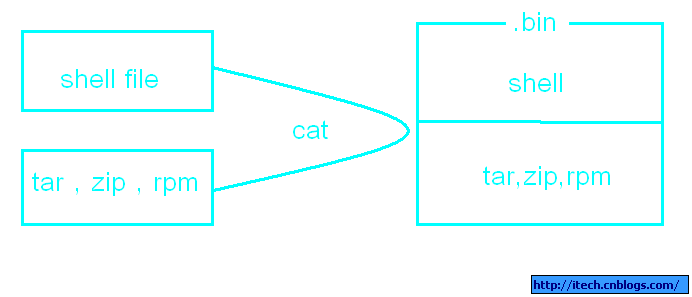一 Linux安装文件
Linux常见的安装为tar,zip,gz,rpm,deb,bin等。我们可以简单的分为三类,
第一:打包或压缩文件tar,zip,gz等,一般解压后即可,或者解压后运行sh文件;
第二:对应的有管理工具的deb,rpm等,通常的这类安装文件可以通过第三方的命令行或UI来简单的安装,例如Ubuntu中的apt来安装deb,Redhat中的yum来安装rpm;
第三:像.bin类,其实就是把sh和zip打包为bin,或把sh和rpm打包为bin等,当在命令行运行bin安装文件时,其实就是bin里面的sh来解压bin中的zip或安装rpm的过程;
二 .bin安装文件
.bin安装文件可以认为是sh文件和zip或rpm等其他安装文件的打包形式。如下图:

.bin安装文件的优点:
1)只有一个包即.bin文件;
2)可以直接运行在Linux上,因为他是sh(他的前半部分是sh);
3)在sh中可以包含需要用户接收的协议信息,而且提示用户接收,如果用户不接收,安装退出;
三 .bin安装文件执行
1)超级简单: sh xxxx.bin 或直接xxxx.bin。
2)过程如下:

四 .bin安装文件制作
1) 组成之sh文件(例子:YYYY.bin)
PATH =/ usr / bin: / bin
umask 022
echo_args = " -e "
localinstall =$ 1
more << " EOF "
XXXXXXXXXXXXXXXXXXXXXXXXXXXXXXXXXXXXXXXXXXXXXXXXXXXXXXXXXXXXXXXXXXXXXXXXXXXxx
EOF
agreed =
while [ x $ agreed = x ] ; do
echo
echo " Do you agree to the above license terms? [yes or no] "
read reply leftover
case $ reply in
y* | Y* )
agreed = 1 ;;
n* | N* )
echo " If you don't agree to the license you can't install this software " ;
exit 1 ;;
esac
done
if [ -d " $localinstall " ] ; then
outname =$ localinstall / OUTNAME
else
outname = OUTNAME
fi
echo " Unpacking... "
tail -n + AAA $ 0 > $ outname
if [ -x / usr / bin / sum ] ; then
echo " Checksumming... "
sum = ` / usr / bin / sum $ outname`
index = 1
for s in $ sum
do
case $ index in
1 ) sum1 =$ s ;
index = 2 ;
;;
2 ) sum2 =$ s ;
index = 3 ;
;;
esac
done
if [ $ sum1 ! = SUM1 -o $ sum2 ! = SUM2 ] ; then
echo " The download file appears to be corrupted. "
echo " Please do not attempt to install this archive file. "
exit 1
fi
else
echo " Can't find /usr/bin/sum to do checksum. Continuing anyway. "
fi
echo " Done. "
exit 0
#此文件YYYY.bin可以重复使用,OUTNAME,SUM1,SUM2均为标识符,表示要打包到bin中的zip,rpm的路径,sum的checksum和filesize。
#用户协议处:XXXXXXXXXXXXXXXXXXXXXXXXXXXXXXXXXXXXXXXXXXXXXXXXXXXXXXXXXXXXXXXXXXXXXXXXXXXxx
#tail -n +AAA $0 > $outname,AAA为此sh文件的line count, 此命令即把bin中的sh后面的zip或rpm提取出来 ;
# sum用来检测所提取的zip或rpm文件是否正确;
#最后一定要exit 0,一定要。
#也可以在退出前云新unzip或rpm来安装,或者由用户自行来安装zip或rpm。
2)组成之zip,gz或rpm (例子:XXXX.rpm)
这个就是你要安装的zip或rpm。
3)创建bin安装文件的脚本sh(例子:createbin.sh,使用上面的YYYY.sh和XXXX.rpm)
PATH =. : $ PATH
RPM = XXXX . rpm
LICENSEBIN = YYYY . bin
BASE =$( basename $ RPM . rpm )
sum = `sum $ RPM`
index = 1
for s in $ sum
do
case $ index in
1 ) sum1 =$ s ;
index = 2 ;
;;
2 ) sum2 =$ s ;
index = 3 ;
;;
esac
done
cat $ LICENSEBIN | sed -e s / OUTNAME /$ RPM / -e s / SUM1 /$ sum1 / -e s / SUM2 /$ sum2 / > linux_license_new . bin
dos2unix -k -q linux_license_new . bin
cat linux_license_new . bin $ RPM > $ {BASE}-rpm . bin
sudo chmod a + x res /$ {BASE}-rpm . bin
# dos2unix 确保license shell为linux格式;
#且此shell文件需要在Linux上执行;
五 参考:http://itboba.com/taxonomy/term/1015
完!
作者: iTech
出处: http://itech.cnblogs.com/
欢迎转载,欢迎加入qq交流群172758282来讨论build_release/Linux/Perl/Python/Jenkins!
